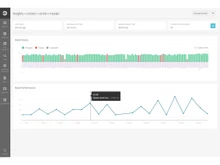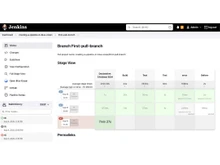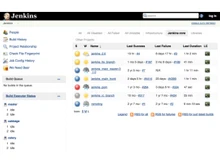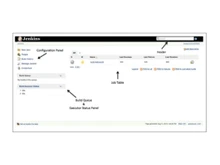CircleCI and Jenkins are popular tools for automating the continuous integration and continuous delivery (CI/CD) processes in software development. While both platforms aim to improve development workflows and software quality, they differ in their approach, features, and implementation. In this quick comparison, we'll examine the key differences between CircleCI and Jenkins, and explore their features, such as server infrastructure, build configuration, user interface, security, pricing, and more.
CircleCI vs. Jenkins: An Overview
CircleCI is a modern continuous integration and delivery platform that automates the building, testing, and deployment of software. It provides a cloud-based, scalable infrastructure to help development teams streamline their workflows, improve code reliability, and accelerate the delivery of high-quality applications. It supports multiple programming languages, Docker, and extensive integrations and enables teams to adopt best practices in continuous integration and delivery of software practices.
On the other hand, Jenkins is an open-source automation software that facilitates continuous integration and delivery processes for software development. It also helps developers automate the building, testing, and deployment of applications across a variety of platforms. With a vast plugin ecosystem and extensible architecture, Jenkins offers flexibility and customization. Due to all these features, Jenkins plays a significant role in empowering teams to achieve efficient, agile software delivery practices.
CircleCI vs. Jenkins: Key Differences
Here are a few key differences between CircleCI and Jenkins:
- CircleCI is a hosted solution with managed infrastructure on AWS. Whereas Jenkins is self-hosted, which requires users to maintain their server infrastructure.
- CircleCI and some of the CircleCI alternatives provide a modern and intuitive web-based UI for monitoring and managing build configurations. Jenkins, on the other hand, offers a web-based UI with customizability and advanced features through plugins.
- Jenkins is open and free to use but may require costs for self-hosted server infrastructure, maintenance, & plugin purchases. Whereas CircleCI offers a variety of pricing plans, including a free tier with certain limitations, and paid plans based on usage and features.
CircleCI and Jenkins: In Terms of Features
Here are some of the key differences between CircleCI and Jenkins in terms of features like plugin support, debugging, parallel processing, configuration language, and more.
- Debugging: CircleCI offers comprehensive build debugging tools, including SSH access to build containers and detailed logging for build steps. Jenkins, on the other hand, provides logging and builds output for debugging.
- Configuration Language: CircleCI uses YAML for defining build configurations, making it easy to read, write, and version control configurations as code. Jenkins, whereas uses Groovy-based DSL for defining build configurations and providing flexibility but with a steeper learning curve for users who are new to the language.
- Parallel Processing: CircleCI provides native support for parallelism in builds, allowing multiple jobs to run simultaneously. Jenkins, in contrast, supports parallel execution through plugins and configurations but also requires some additional setup.
- Plugin Support: CircleCI provides a marketplace of integrations and orbs (reusable packages of configuration), offering a broad range of integrations for various tools and services. Jenkins, however, is known for its extensive plugin ecosystem, allowing users to extend functionality through many community-developed plugins.
- Docker Workflow: CircleCI offers built-in support for Docker workflows, allowing seamless integration and orchestration of Docker containers in builds. Jenkins on the other hand requires an additional setup and plugins for Docker support, though it has a robust Docker plugin ecosystem.
CircleCI vs. Jenkins: Server
CircleCI is a hosted solution with managed infrastructure on AWS. On the other hand, Jenkins is a self-hosted solution, which means users are responsible for maintaining the server infrastructure on their own.
CircleCI or Jenkins: Build Control/Build Configuration
CircleCI uses a YAML configuration file for defining and controlling builds. Jenkins, on the other hand, allows building configuration through a graphical interface, or by defining build scripts using Groovy or other scripting languages.
CircleCI and Jenkins: User Interface
CircleCI provides a modern and intuitive web-based UI for monitoring and managing builds. Jenkins on the other hand, offers a web-based UI, but the interface is more customizable and may require additional plugins for advanced dashboard features.
CircleCI vs. Jenkins: Data Protection
CircleCI offers encryption of data at rest as well as in transit and maintains industry-standard security practices for data protection. Similarly, in the case of Jenkins, data protection depends on how well the self-hosted server is secured and maintained by users.
CircleCI and Jenkins: Setup & Maintenance
CircleCI offers managed services, reducing the need for users to handle server setup and maintenance. Apart from that, updates and patches are managed by CircleCI. In contrast, Jenkins requires users to set up and maintain their server infrastructure, including managing updates, security patches, as well as plugin compatibility.
CircleCI or Jenkins: Build Environment
CircleCI offers a customizable build environment with a variety of pre-installed tools and languages and allows for defining custom environments. However, in the case of Jenkins, users have full control over the build environment but need to configure and manage the required tools as well as dependencies.
CircleCI or Jenkins: Performance
CircleCI is known for its fast build times and efficient resource allocation, with built-in caching and parallelism support. In contrast, the performance of Jenkins varies based on server configuration and workload and requires additional optimization for build execution.
CircleCI and Jenkins: Permissions
CircleCI offers granular permission control with customizable access levels for different team members. It also supports integrations with LDAP/SSO for user management. While Jenkins supports permission control through plugins and user management and requires additional setup for fine-grained access control.
Circle CI vs Jenkins: Security
CircleCI provides various security features such as secure environment variables, access controls, access management, and regular security updates for the managed infrastructure. On the other hand, the security of Jenkins relies heavily on user configuration and maintenance, including securing the server, managing user privileges, and staying up to date with security patches.
Circle CI vs Jenkins: Infrastructure Deployments
CircleCI integrates seamlessly with various deployment platforms and cloud providers, facilitating continuous deployment pipelines. Jenkins supports deployment through plugins and scripting, providing flexibility in integrating with a wide range of deployment targets.
Verdict: CircleCI vs. Jenkins
In summary, CircleCI and Jenkins offer distinct approaches to continuous integration and delivery. CircleCI provides a managed, cloud-based solution with native support for parallelism, Docker workflows, and modern UI, making it well-suited for teams seeking seamless automation. On the other hand, Jenkins, being a self-hosted platform, offers extensive customization, a vast plugin ecosystem, and cost-effective options, appealing to organizations with specific infrastructure requirements and customization needs. In short, if someone needs a managed, scalable solution, then they can opt for CircleCI. On the other hand, if someone needs a flexible, self-hosted platform with extensive customization options, then Jenkins is a suitable option.


 3 Ratings & 0 Reviews
3 Ratings & 0 Reviews


















